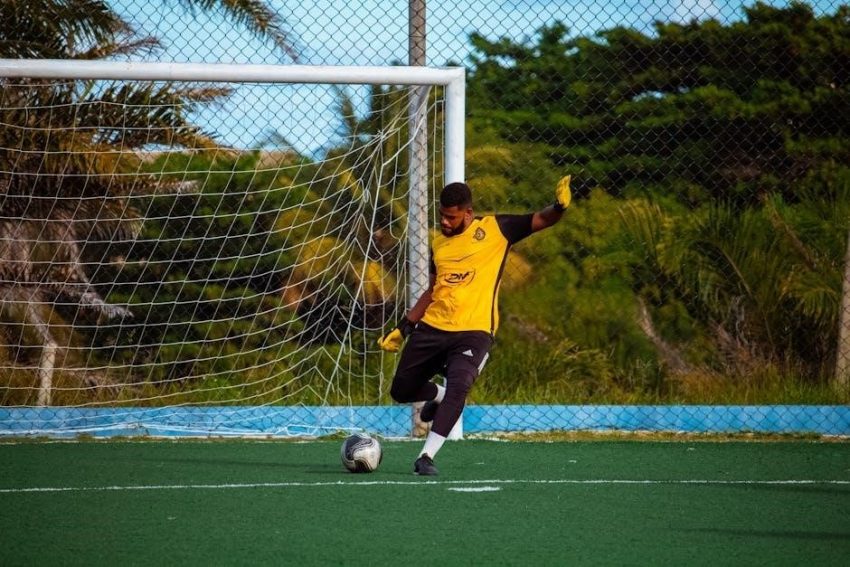A comprehensive guide for youth football, this playbook focuses on base formations like 4-4, 5-3, and 6-2 defenses, blitz packages, and coverage schemes such as Cover 1, 3, and 4.
It emphasizes simplicity and effectiveness, helping young players master fundamental defensive strategies while preparing coaches to adapt schemes to their team’s strengths.

Base Defensive Formations
Base defensive formations include the 4-4, 5-3, and 6-2 schemes, each offering unique strengths for stopping the run and pass. These setups provide a foundation for adapting to offenses.
The 4-4 defense features four linemen and four linebackers, balancing run and pass defense with flexibility for blitzing and coverage adjustments.
The 5-3 defense emphasizes stopping the run with five linemen and three linebackers, ideal for teams needing strong gap control and physical play;
The 6-2 defense uses six linemen and two linebackers, focusing on overwhelming the offense at the line of scrimmage with aggressive pressure.
2.1. 4-4 Defense
The 4-4 defense is a balanced formation featuring four defensive linemen and four linebackers. It excels at stopping the run and provides flexibility for blitzing and coverage adjustments.
This scheme allows outside linebackers to cover slot receivers, simplifying adjustments while maintaining a free safety in the middle for deep support. It is particularly effective in youth football, offering a straightforward setup for young players to execute fundamental defensive strategies.
2.2. 5-3 Defense
The 5-3 defense is a stout formation with five defensive linemen and three linebackers, ideal for stopping the run and pressuring the quarterback. It places eight defenders in the box, making it difficult for offenses to establish a ground game.
This scheme is particularly effective in youth football, where physicality and alignment are critical. The free safety provides deep coverage, while linebackers and defensive linemen focus on stopping the run and rushing the passer. It offers simplicity for young players to execute and adapt, making it a popular choice for youth teams looking to build a strong defensive foundation.
2.3. 6-2 Defense
The 6-2 defense features six defensive linemen and two linebackers, maximizing defensive presence at the line of scrimmage. This formation excels in stopping the run, with linemen occupying blockers and linebackers flowing to the ball. In youth football, it simplifies responsibilities, allowing players to focus on execution rather than complex adjustments. The free safety provides deep support, while corners play press coverage to disrupt receivers. This scheme is ideal for teams with strong linemen, as it creates consistent pressure and limits offensive rushing lanes. It’s a straightforward yet effective strategy for young defenders to build confidence and dominate against run-heavy offenses.
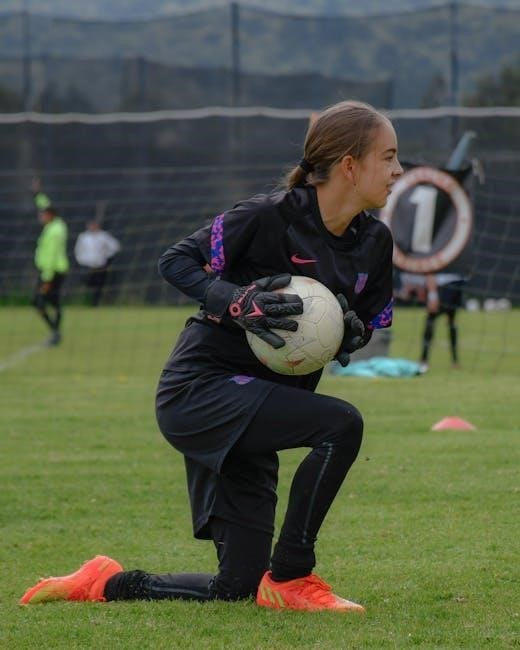
Coverage Schemes
Coverage schemes like Cover 1, 3, and 4 provide structured defensive back techniques. These schemes simplify assignments for young players, ensuring effective pass defense while supporting the run.
3.1. Cover 1
Cover 1 is a man-free coverage scheme where defensive backs match receivers, and a free safety provides deep support. It’s ideal for pressuring offenses with blitzes, as the single safety covers the deep zone. Linebackers and corners focus on their assigned targets, ensuring tight coverage. This scheme simplifies reads for young players, allowing aggressive playmaking. Coaches often pair Cover 1 with blitz packages to maximize pressure on the quarterback. Proper alignment and communication are key to avoiding gaps in coverage. It’s a fundamental scheme that teaches defensive backs to track receivers and react to the ball effectively.
3.2. Cover 3
Cover 3 is a zone-based coverage scheme that divides the field into three deep zones, typically patrolled by the free safety and two cornerbacks. The corners play the deep thirds, while linebackers and nickelbacks cover the underneath zones. This scheme is effective against vertical passes and allows defensive backs to read the quarterback’s eyes. It’s simpler for young players, as they focus on specific zones rather than individual receivers. Linebackers must drop quickly to their hook-to-curl zones, while the free safety provides over-the-top support. Cover 3 is versatile and often used in youth football to teach zone concepts and teamwork in pass defense.
3.3. Cover 4
Cover 4, also known as “Quarter, Quarter, Half,” is a zone coverage where two safeties each cover deep halves of the field, and the two cornerbacks handle the underneath quarters. This scheme is excellent for preventing big plays and providing support to cornerbacks. It allows defensive backs to read the quarterback and react to the ball. Linebackers typically cover the hook-to-curl zones, while the safeties rotate to the ball. Cover 4 is effective in youth football as it teaches players to cover zones and communicate. It’s a balanced defense that limits deep passes and provides support in the intermediate zones, making it a valuable tool for coaches to simplify pass defense.
Blitz Packages
Blitz packages add pressure on the offense with 7 blitzes and 4 stunts, building around base gap calls and formation alignments to create confusion and disrupt plays effectively in youth football.
4.1. Types of Blitzes
In youth football, blitzes vary to challenge offenses effectively. Common types include man blitzes, where linebackers or defensive backs attack the quarterback, and zone blitzes, combining pressure with coverage.
Blitzes like the dog blitz involve linebackers rushing from the inside, while corner blitzes use defensive backs to surprise the quarterback. Each blitz type is designed to exploit offensive weaknesses and create turnovers.
4.2. Setting Up Blitzes
Setting up blitzes effectively requires careful planning and alignment. Coaches should identify offensive formations and strengths to determine the best blitz angles. Timing is crucial, as blitzers must synchronize their attack to catch the offense off-guard.
Blitzes are often aligned with the defense’s strength call, ensuring maximum pressure on the quarterback. The free safety and linebackers play key roles in executing blitzes, while defensive backs provide coverage support. Practicing blitz drills enhances execution and teamwork.
Defensive Line Techniques
The defensive line is the backbone of any defense, responsible for containing the run and pressuring the quarterback. Techniques like proper stance, hand placement, and footwork are essential for success. Linemen must master shedding blocks and maintaining gap responsibility to prevent offensive progress.
Defensive linemen should align based on the offensive formation, focusing on angles and leverage. Reading the offense’s blocking schemes helps anticipate plays. Techniques such as the “rip” and “swim” moves allow linemen to defeat blocks and penetrate the backfield. These skills are critical for stopping both run and pass plays effectively.

Linebacker Responsibilities
Linebackers serve as the defensive unit’s quarterbacks, responsible for reading offensive plays and directing teammates. Their primary roles include filling run gaps, covering receivers, and supporting both the defensive line and secondary. Proper alignment and pre-snap reads are crucial for anticipating offensive schemes.
In youth football, linebackers often focus on simple, effective assignments like plugging holes in the run game and dropping into zone coverage. They must communicate effectively, ensuring all defensive players are aligned correctly. Quick decision-making and tackling skills are essential for stopping offensive drives and creating turnovers.
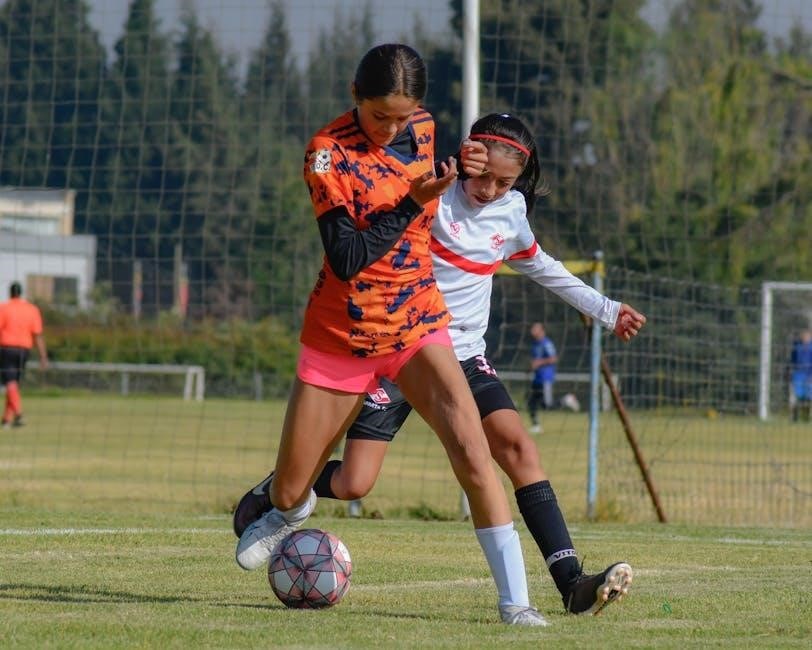
Defensive Back Techniques
Defensive backs must master techniques like footwork, body positioning, and reading receivers to excel in coverage. Proper alignment and understanding of assignments are critical for executing schemes like Cover 1, Cover 3, and Cover 4 effectively.
In zone coverage, defensive backs focus on patrolling their designated areas, reacting to the ball, and providing support. In man coverage, they must mirror receivers’ movements and maintain tight coverage. Tackling skills are also essential for defensive backs to limit gains after completions.
Communication and discipline are key, ensuring seamless coordination between the secondary and linebackers. Drills like backpedaling and turning to locate the ball help refine these skills, preparing defensive backs to perform confidently in game situations.
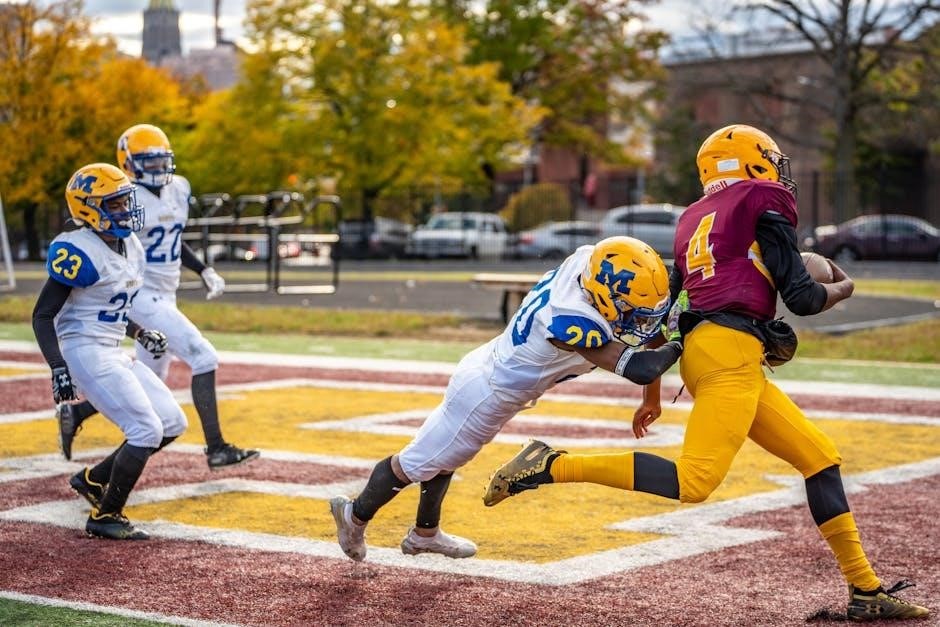
Goal Line and Prevent Defenses
Goal Line Defense is crucial for preventing touchdowns when the offense is near the end zone. It often involves stacking the box with 7 or 8 defenders to stop runs. Prevent Defense is used to avoid big plays, usually when leading late. It employs deep safeties and zone coverage to allow some yards but prevent scores. Both strategies require precise communication and alignment to be effective. These defenses are essential for youth football teams to manage high-pressure situations and protect leads or prevent scoring opportunities. By understanding these tactics, young players can better handle critical game moments and strengthen their team’s defensive capabilities. Proper execution of these defenses can significantly impact the game’s outcome.
Reading Offensive Formations
Reading offensive formations is key to anticipating plays and aligning the defense effectively. Youth defenders should focus on the offensive linemen’s alignment, the quarterback’s position, and the distribution of receivers and backs. Common formations include Pro Set, I-Formation, and Shotgun, each signaling potential play types. For example, a heavy tight end side may indicate a run, while a spread formation suggests a pass. Linebackers and defensive backs must communicate adjustments based on these reads. Proper recognition allows the defense to set the strength call, ensuring alignment and coverage match the offense’s threat. Effective formation reading enhances defensive execution and helps players make quicker decisions during the game. This skill is fundamental for building a disciplined and adaptive defense.

Adjusting Defensive Schemes
Adjusting defensive schemes is crucial for countering various offensive strategies. Coaches must identify the opponent’s strengths and adapt the defense accordingly. For instance, shifting to a 5-3 defense can bolster run support, while switching to Cover 4 provides deeper zone coverage against pass-heavy offenses. Linebackers and defensive backs must align based on offensive formations, ensuring proper gaps and coverage. Blitz packages can be tailored to pressure the quarterback, while stunts disrupt blocking schemes. Effective adjustments require clear communication and quick execution. By reading the offense and making timely changes, the defense can neutralize threats and create turnovers. This adaptability is essential for youth football teams to succeed against diverse opponents. Proper adjustments enhance defensive execution and keep the offense guessing.

Practicing Defensive Plays
Effective practice of defensive plays is essential for building a strong, cohesive unit. Coaches should emphasize alignment, assignment, and execution in drills. Start with individual position drills to refine techniques like tackling, shedding blocks, and coverage skills. Progress to group drills, such as 7-on-7 or 11-on-11 scenarios, to simulate game situations. Incorporate hustle drills to improve speed and agility. Focus on reacting to offensive formations and adjusting schemes accordingly. Repetition is key to developing muscle memory and confidence. Ensure players understand their roles in base defenses, blitzes, and coverage. Film review and feedback sessions can help identify and correct mistakes. A well-structured practice plan ensures the defense is prepared for any offensive challenge. Consistent practice builds a resilient and adaptable defensive team.
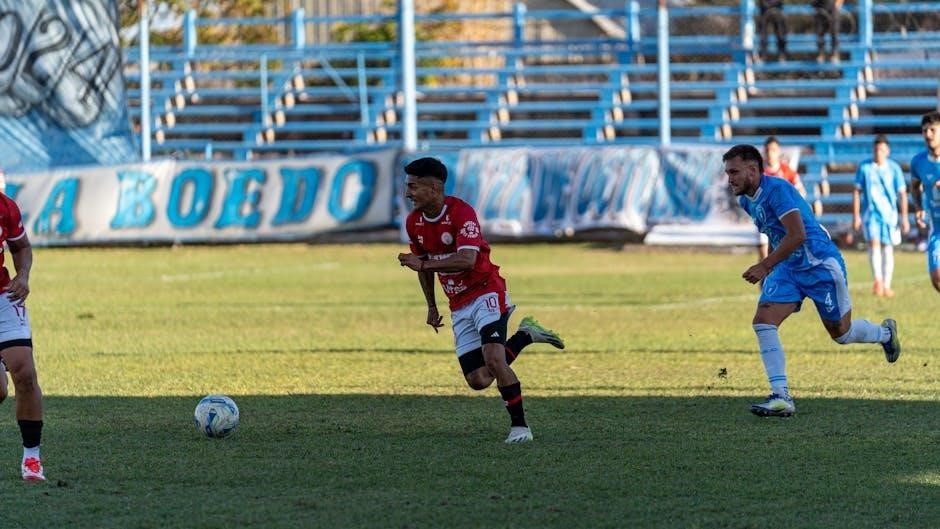
Common Mistakes to Avoid
One of the most common mistakes in youth football defense is improper alignment and assignment. Players often misjudge offensive formations, leading to coverage gaps. Another error is poor tackling technique, which can result in missed tackles and big plays. Defensive backs frequently struggle with staying disciplined in coverage, especially in zone schemes. Linebackers may overcommit to the play, leaving vulnerabilities in the defense. Additionally, lack of communication can lead to confusion and breakdowns. Coaches should emphasize the importance of staying in assigned gaps and trusting the scheme. Players must avoid overpursuing and maintain containment on the outside. Improving these areas through repetition and drills can significantly enhance defensive performance and reduce costly mistakes during games.
